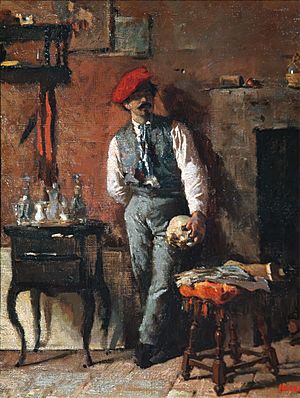Jeronimo Suñol facts for kids
Jeronimo Suñol y Pujol (born December 13, 1839, died October 16, 1902) was a famous Spanish sculptor. He was born in Barcelona, Spain.
He learned sculpture from Agapit and Venanci Vallmitjana. Later, he moved to Rome, Italy, to improve his skills. He had his own art studio there for many years. Even though he didn't create a huge number of works, he was one of the best sculptors of his time in Spain. He helped change sculpture from old-fashioned, abstract styles to more realistic ones. Jeronimo Suñol passed away in Madrid.
Famous Sculptures by Jeronimo Suñol

Portrait of Jeroni Suñol by Marià Fortuny
- Dante (1864): This important sculpture helped Suñol become well-known. It shows the famous poet Dante Alighieri sitting and thinking deeply. A plaster model of this work won a medal in Madrid in 1864. Suñol also showed it in Paris in 1869. He made several marble copies for different art collectors. A bronze version was made for Barcelona in 1901.
- Himeneo (1866)
- Petrarca (1867)
- O'Donnell Monument (1870): This is a funeral monument for General Leopoldo O'Donnell, 1st Duke of Tetuan. It is located in the Convent of the Salesas Reales in Madrid.
- Alvarez de Castro Monument (1880): This is another funeral monument, made for General Mariano Álvarez de Castro.
- Statue of Christopher Columbus (1886): Suñol created the main statue for the Columbus monument in Madrid. A copy of this statue was made in 1892 and can be found in Central Park, New York City.
- Saint Peter and Saint Paul: These two statues are located in the Basilica of San Francisco el Grande in Madrid.
- Marqués de Salamanca (1902): This sculpture is a very realistic portrait for a public monument. It was Jeronimo Suñol's last work. You can see it in the Plaza del Marqués de Salamanca in Madrid.
See also
 In Spanish: Jerónimo Suñol para niños
In Spanish: Jerónimo Suñol para niños

All content from Kiddle encyclopedia articles (including the article images and facts) can be freely used under Attribution-ShareAlike license, unless stated otherwise. Cite this article:
Jeronimo Suñol Facts for Kids. Kiddle Encyclopedia.

